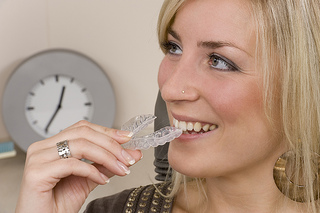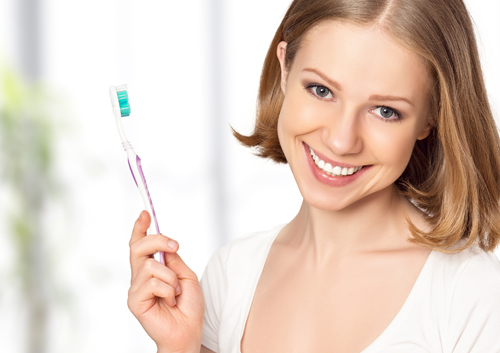
Every year, over 50,000 North Americans are diagnosed with oral or throat cancer, which has a higher death rate than many other common cancers, including cervical cancer, testicular cancer, Hodgkin’s lymphoma, and thyroid or skin cancers. The high death rate results from the fact that most oral cancers go undiagnosed until the disease is well advanced and has spread to another part of the body, most often, the lymph nodes in the neck.
Because oral cancer is typically painless in its early stages and often goes undetected until it spreads, many patients aren’t diagnosed until they are already suffering from chronic pain or loss of function. However, if detected early, Dr. Sheklian and our team at Squan Family Dentistry want you to know that early detection of oral cancer improves the survival rate to 80 percent or more.
If you visit our Manasquan office regularly, you have probably received an oral cancer screening and didn’t even realize it. That’s because the exam is quick and painless; Dr. Sheklian and our team check your neck and mouth for signs of oral cancer such as discolorations, lumps, or any changes to your tissue. Oral cancer is typically found on the tongue, lips, gums, the floor of the mouth, or tissues in back of the tongue.
Factors that may influence your risk for developing oral cancer include:
In between your visits to our office, it is critical for you to be aware of the following signs and symptoms, and give us a call if these symptoms don’t go away after two weeks.
During your next visit, Dr. Sheklian will examine your mouth for signs of oral cancer. If you have been putting off a visit to our Manasquan office for your regular checkup, now is an excellent time to schedule one. Regular visits can be the first line of defense against oral cancer because we can identify early warning signs of the disease. Give us a call today!

It’s estimated that up to four million people at any one time are wearing braces in the United States and Canada. But Dr. Sheklian and our team at Squan Family Dentistry know that braces have come a long way from the early days of orthodontics, so much so that these days, options are available that are not visible to onlookers. The most popular of these “invisible” braces is Invisalign. Here’s a list of FAQs regarding Invisalign:
Are they really invisible?
Yes, the clear liners are virtually invisible, so they enable patients to feel good about themselves and their appearance, while getting the orthodontic treatment they need.
Are there wires, rubber bands, and brackets with Invisalign?
Nope. Invisalign is truly an alternative to conventional braces. The treatment consists of clear liners that can easily be removed and cleaned throughout the day. There are no wires, so there’s less poking and mouth irritation compared to braces. There’s also no wire tightening at adjustment appointments, so patients don’t have to worry about a sore mouth in the days that follow in-office visits.
I’ve heard that if I get braces, I won’t be able to eat certain foods like popcorn and hard candy. Is this true with Invisalign too?
No. With Invisalign, there are no food restrictions. You simply remove your aligners when you’re eating, and replace them after you’ve finished and brushed any leftover food particles away.
Does Invisalign cost more than braces?
While overall cost varies on a patient-by-patient basis and is based largely on the level of treatment, Invisalign costs about the same as traditional braces, which makes this treatment option a truly affordable alternative.
How does brushing compare with conventional braces?
Brushing your teeth while wearing conventional braces takes some getting used to. Patients have to brush around the metal brackets and floss with a specialty tool to get into the hard-to-reach areas of the mouth. By contrast, Invisalign can be removed at any time to permit regular brushing and flossing.
Every patient is different and Invisalign might not be the best course of orthodontic treatment for everyone, but it’s an option that’s gaining more and more popularity, and it’s an orthodontic alternative that doesn’t sacrifice comfort and convenience for results. For more information, or to schedule a consultation, please give us a call at our convenient Manasquan office!

Brushing your teeth twice a day with fluoride toothpaste that has the American Dental Association seal of approval can help prevent tooth decay and relieve other conditions, such as bad breath, sensitive teeth, and gingivitis.
Beyond these health effects, another motivation for frequently brushing your teeth with high-quality toothpaste is to keep your teeth white. If you want whiter teeth but do not want to undergo in-office or at-home bleaching treatments, you might consider choosing whitening toothpaste for your daily brushing.
Why Consider Whitening Toothpaste
Whiter teeth are more attractive, which can help you feel more confident in your smile. Your smile is also one of the main components of the first impression you make on people in your professional and personal life. Having a whiter smile and greater self-assurance can send the message that you take care of yourself and are confident in your abilities.
How Whitening Toothpaste Works
The American Dental Association explains that all toothpaste has whitening properties because they help remove food particles from your teeth. To carry the American Dental Association seal for whitening, however, toothpaste must contain certain chemicals that help remove stains.
Unlike bleaching products, which contain carbamide peroxide or hydrogen peroxide, whitening toothpaste only cleans the enamel rather than changing the color of your teeth. To obtain the benefits of whitening toothpaste, you need to use it regularly.
The Effectiveness of Whitening Toothpaste Varies
Due to individual variations in the color of your teeth, some people are more likely than others to achieve the desired results with whitening. Teeth that are tinted grayish are unlikely to respond well to bleaching, while brown teeth can sometimes respond, and yellowish teeth are most likely to become pearly white with bleaching.
If Dr. Sheklian and our staff believe that bleaching is not a viable option for you, proper oral hygiene and the use of a whitening toothpaste are your best bets for keeping your teeth as white as possible. In addition, avoid using tobacco products, and rinse your mouth after drinking coffee.

The community health awareness group Oral Health America has reported that 82 percent of adults are unaware of the role that infectious bacteria can play in tooth decay or cavities, and almost three out of five children aged 12 to 19 have tooth decay. Since June is National Smile Month, Dr. Sheklian and our team at Squan Family Dentistry thought we’d remind our patients about the importance of good oral hygiene visits between office visits.
To keep your family’s smiles healthy and beautiful for years to come, be sure to:
If you want to know more about healthy home care habits, feel free to ask our team at your next appointment, or ask us on Facebook!